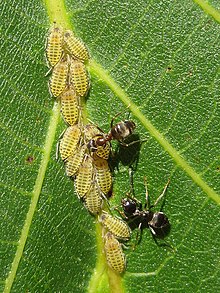
Myrmecophily (/mɜːrməˈkɒfəli/ mur-mə-KOF-ə-lee, lit. 'love of ants') consists of positive, mutualistic, interspecies associations between ants and a variety of other organisms, such as plants, other arthropods, and fungi. It may also include commensal or even parasitic interactions.
A "myrmecophile" is an animal that associates with ants. An estimated 10,000 species of ants (Formicidae) are known, with a higher diversity in the tropics.[1] In most terrestrial ecosystems, ants are ecologically and numerically dominant, being the main invertebrate predators. As a result, ants play a key role in controlling arthropod richness, abundance, and community structure.[2] Some evidence shows that the evolution of myrmecophilous interactions has contributed to the abundance and ecological success of ants,[1][3] by ensuring a dependable and energy-rich food supply, thus providing a competitive advantage for ants over other invertebrate predators.[4] Most myrmecophilous associations are opportunistic, unspecialized, and facultative (meaning both species are capable of surviving without the interaction), though obligate mutualisms (those in which one or both species are dependent on the interaction for survival) have also been observed for many species.[5]
As ant nests grow, they are more likely to house more and greater varieties of myrmecophiles. This is partly because larger colonies have greater specializations, so more diversity of ecology within the nests, allowing for more diversity and population sizes among the myrmecophiles.[6][7]
- ^ a b Hölldobler & Wilson 1990.
- ^ Fiedler, K.; Hölldobler, B.; Seufert, P. (1996). "Butterflies and ants: The communicative domain" (PDF). Experientia. 52 (1): 14–24. doi:10.1007/BF01922410. ISSN 0014-4754.
- ^ Hölldobler & Wilson 1998.
- ^ Blüthgen, Nico; E. Stork, Nigel; Fiedler, Konrad (2004). "Bottom‐up control and co‐occurrence in complex communities: honeydew and nectar determine a rainforest ant mosaic" (PDF). Oikos. 106 (2): 344–358. doi:10.1111/j.0030-1299.2004.12687.x. ISSN 0030-1299.
- ^ Stadler & Dixon 2008.
- ^ Kistner, David H. (1979). Social and Evolutionary Significance of Social Insect Symbionts. Elsevier. pp. 339–413. doi:10.1016/b978-0-12-342201-9.50015-x. ISBN 978-0-12-342201-9.
{{cite book}}:|work=ignored (help) - ^ Wilson 1971.